Seedling method

Rarely, but still it happens that with this method of planting, a perennial mallow flower blooms in the same year. And the sooner you sow the seeds, the more chances you will see beautiful flowers in the year of planting.
Mallow seeds are planted on seedlings from March to May. If sown in March, then transplant the plant to the flowerbed in May-June. If the sowing was delayed, then you will have to plant seedlings almost in the month of August.
If you decide to sow in March, then prepare lamps to provide the plant with additional lighting.
Common boxes are not suitable for planting mallow for seedlings, since a still very young plant has not only a powerful stem, but also a powerful root system, and it can be damaged when transplanted into open ground. Damaged roots can cause a long engraftment of a plant in a new place, slow growth, and even death of a flower. Take not even peat pots (they are too small), but flower pots or half-liter plastic cups (you can cut off half a two-liter or one and a half-liter plastic bottle).
Fill the pots with potting soil made for flowering plants. Then put the seeds, sprinkle a little, but do not bury it deeply, pour it over. Next, you just have to regularly water the soil (do not allow the soil to dry out), maintain the temperature at least +18 degrees. If all these rules are observed, sprouts will appear in 2-3 weeks.
Preparing the soil for planting
To plant a stock rose, choose a spot in the garden that is bathed in sunshine. The flower tolerates partial shade well, but the flowers will lose their brightness. Drain pebbles before planting in holes. It is better to choose a loose, loamy soil, rich in humus. So that the roots of the plant do not rot, and the melt water does not heat it, choose a place for the mallow on a hill. Find an area free of drafts and winds. It is best to place the seedlings near the fence, which will serve as a support, because the stems of an adult plant are very high. Poor soil must be fertilized with humus and mulched with sawdust, peat.
Perennial mallow: planting and care
 In one place, a plant can grow without any transplants for a long time, so the site must immediately meet all the conditions for growing a flower.
In one place, a plant can grow without any transplants for a long time, so the site must immediately meet all the conditions for growing a flower.
Mallows love well-lit places, protected from direct sunlight and strong winds. The best soil for them is light loam. It must be well-drained and nutritious.
Mallow seeds for seedlings are sown at home in April or early May. Sowing in open ground is carried out at the end of June. The seedlings grown in the house are planted on the site only at the end of August.
Mallow does not require special care. It is enough to water them on time and regularly and sometimes to feed them. In warm weather, watering is done once a week, and on hot days, the bushes are watered abundantly. The stock-rose does not like stagnation of water in the soil, therefore, waterlogging of the soil should not be allowed.
Once every 15-20 days, mallows are fed with a weak solution of phosphorus-potassium fertilizers. For additional aeration, the soil is periodically recommended to be cleaned of weeds and loosened. This must be done very carefully so as not to damage the delicate root system of the stem-rose.
To prevent the wind from breaking tall bushes, they need to be tied to supports. Around the middle of summer, you can collect and prepare seeds from the plant. After flowering, the stalks of the mallow are cut off.
In the fall, caring for mallow consists in preparing the plant for wintering. To do this, use fallen leaves, which cover the areas where stock-rose bushes grow.
The appearance of small red spots on the leaves may indicate that the plant has been damaged by rust. Mallows can also be prone to mosaic and powdery mildew.Therefore, it is not recommended to plant them for two years on areas previously infected with these diseases. When signs of one of these diseases appear, the affected leaves are cut off and burned, and the bushes must be treated with fungicidal preparations.
Types and varieties of mallow flower (mallow)
Mallow in the Moscow region is not very common, but it is widespread to the south - in the Volga region, in the Caucasus, in the Ukraine. In the Moscow region and to the north, the plant is replaced by another species very similar to it - low mallow (M. pusilla). It is even more inconspicuous than neglected mallow, its petals are only slightly longer than the calyx, very pale and almost invisible. Otherwise, the plants look like twins. This species is very often found throughout the Moscow region and throughout the European part of Russia, except for the Arctic, throughout Siberia and the Far East.
Both types of mallow are used in folk medicine, their leaves and roots in the form of decoctions are used for rinsing in inflammatory processes of the respiratory tract, as an external lotion for skin inflammations, ulcers, tumors, hemorrhoids. Greens have a slightly laxative effect. The use of mallow flowers is recommended for constipation and intestinal atony. In addition, it is believed that the mucus released when chewing mallow makers protects against colds. Fresh grass contains almost 88% water, 4.9% nitrogenous substances, up to 243 mg% vitamin C. There is also a lot of ascorbic acid in unripe fruits.


In terms of protein content, some types and varieties of mallow used as fodder surpass even legumes famous for their nutritional value. These types include Mogilev mallow (M. mohielevansis). The most interesting thing is that this native of China somehow turned out to be discovered in 1861 in Ukraine, from where it got its name. In China, it is also used as a wild food plant, and in our country it is introduced here and there as a fodder.

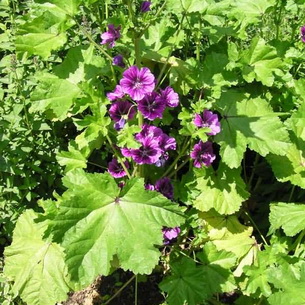
A little further south there are beautiful bushes of forest mallow (M. sylvestris) with bright, rather large flowers. It is found in the Baltics, then with a large gap in the Volga region and further south, to the Caucasus and Central Asia. It was also grown in ancient Greece. According to one of the researchers, the nature of its distribution in Germany and the discovery of seeds in the sites of the early Iron Age proves that it was originally a cultivated plant.


Terry red. Height 1.8-2.2 m, powerful bush, inflorescence from 55 to 110 cm.
As you can see in the photo, the flowers of this mallow are double, bright red, in the form of a hemisphere:


The petals have dark streaks. The number of flowers in the inflorescence reaches 180 pieces.
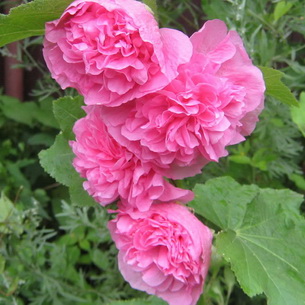
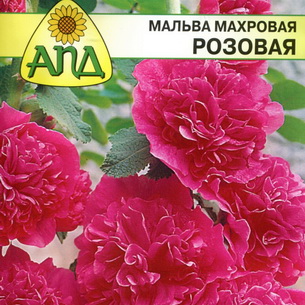
Terry pink. Height 2–2.5 m. One of the most decorative varieties. Has a bright pink color. The diameter of the flower reaches 12 cm. The length of the inflorescence is 1 m. The number of flowers in the inflorescence is up to 190.
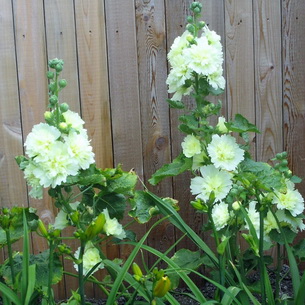
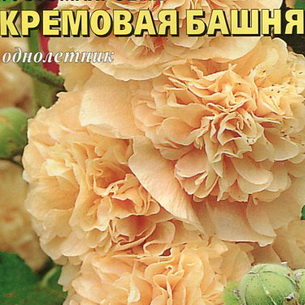
Terry cream. Height 2 m. The stem is powerful, branched. The inflorescence is about 1 m long, the number of flowers in it is up to 200 pieces, the diameter is from 10 to 12 cm.
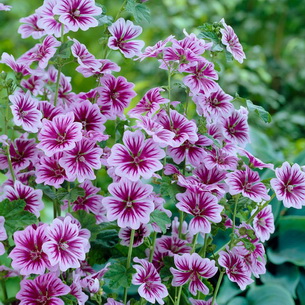

Zebrina. Height 1.2 m. Very decorative variety of mallow, raspberry, with dark stripes. The plant reproduces by self-seeding. Blooms from May to frost.
In Siberia, there are 4 edible types of mallow, all of them are annual plants.
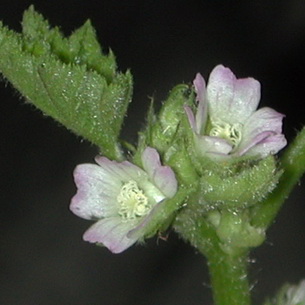
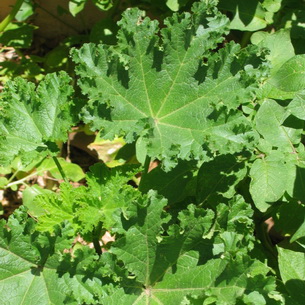
1. Curly mallow - Malva crispa (L.) L.
Stem 40-100 cm tall. Blooms from July to September.
Occasionally found in the southern regions of Siberia, as a weed - near dwellings.
Young leaves and shoots are eaten raw (for salad) and boiled.


2. Malva mauritanian, forest - Malva mauritiana L.
Stem 30-100 cm tall. Blooms in July - August.
Used as food, like curly mallow.

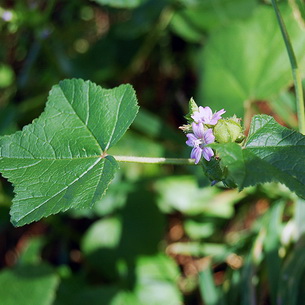
3. Mogilev mallet, whorled - Malva mohileviensis Downer.
Stem height 35-100, rarely 150 cm. Blooms in July - August.
They are used for food, like the previous types of mallow.

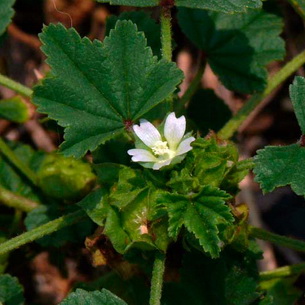
4. Low mallow, small, "kalachiki" - Malva pusilla Smith
Stem 20-60 cm tall. Blooms in July - August.
General description of perennial mallow and its types
In growth, this plant reaches from one and a half to two meters.The types are varied, consider the most popular. It has large flowers 5–15 cm in size. The color range is diverse, as are the species, they differ in plant growth and double flowers.
There are also varieties in which the inflorescences are arranged in whole clusters. This miracle blooms all summer from spring - May, and ending at the end of summer. The plant has a large branched root system, so it does not suffer from drought as much as other inhabitants of the site.
- "Forest mallow" is a biennial plant, but in many places it is grown as an annual. It grows up to a meter, has flowers with faded petals than veins. The color scheme of the flower is different. "Zebrina" - large flowers of pale pink color with red veins. "Black mother-of-pearl" is a self-explanatory name, this variety has dark purple flowers with black veins, the diameter reaches 7 cm.
-
"Musk mallow" is not a very tall perennial, the stems reach a height of no more than a meter. With white or pink flowers, the diameter of which is 5 cm. This species blooms until frost. The aroma delights with its charm. Popular varieties:
- "White Tower" - white flowers;
- "Pink Tower" - pink flowers.
- "Hybrid mallow" is about 2 meters high, blooms with white and pink inflorescences.
- "Wrinkled mallow" or stock-rose is one of the most demanded plant species among our gardeners, it can be found in almost every area. It grows 2.5 meters in height and has flowers of various colors and sizes.
- "Treelike mallow" is a perennial plant, popularly called garden hibiscus, grows up to three meters. Looks like a large shrub or even a tree.
Types and varieties of mallow
In an annual culture, the following types of mallow are grown:
Malva (mallow) whorled, or curly (Malva crispa = Malva verticillata) comes from the subtropics of Asia, mostly from China, but it can also be found in Western Europe, Japan, Eastern and Western Siberia. This plant is up to 2 m high with straight, pubescent in the upper part or bare stems. Its leaves are spectacular: long-petiolized, large, up to 16 cm long, finely toothed and curly along the edge. They are often used as an addition to bouquets and ingredients in salads. Almost sessile, numerous flowers, pale pink or white, collected in the axils of the leaves. Flowering begins in June. This mallow has been cultivated since 1573.
Malva neglecta is found everywhere in Europe. Its shoots first grow horizontally, and then change direction to vertical and rise half a meter above the ground. The flowers of this species are up to 2 cm in diameter, axillary, white, streaked with pink-purple stripes;
Hybrid mallow (Malva x hybrida semperflorens) is a perennial grown both in one-year and two-year (Gibbortello form) culture. It reaches a height of 2 m, it usually has several stems; flowers are large, double, white, red or pink. Flowering begins in June and ends in autumn.
In annual, biennial and perennial crops grown:
Forest mallow (Malva sylvestris) is a plant with a height of 30 to 120 cm with ascending branchy stems, covered, like rounded long-petied, serrated along the edges of five to seven-lobed leaves, with a long pile. Flowers of this species, pink with darker stripes along the petals, can be single, and they can grow in the axils of the leaves in several pieces. Forest mallow blooms from May to September. The most popular varieties of the species are Moravia (with dark pink flowers with bright red veins), Primli Blue (a creeping plant with shoots up to 1 m long) and Zebrina (a variety with light pink flowers with purple-red veins);
Mauritanian mallow (Malva mauritiana) is considered by some botanists to be a species of forest mallow, but most scientists distinguish it as a separate species. The stem of this plant is erect, almost naked. In the axils of the leaves, from 5 to 15 pink flowers with dark stripes are formed.
The following types of mallow are grown as perennials:
Musk mallow (Malva moschata) is a plant native to Western Europe and Asia Minor, reaching a height of 1 m. It has rough hairy stems and pink or white flowers with a musky aroma, up to 5 cm in diameter. The plant has been cultivated since 1596. Flowering occurs from June to August. The species has high winter hardiness: it can withstand frosts down to -35 ºC. The most famous variety is White Perfection - a plant with a height of 35 to 70 cm with numerous snow-white flowers up to 5 cm in diameter;
Malva (stockrose) wrinkled (Malva rugosa = Alcea rugosa) is a perennial with a height of 80 to 120 cm, which is not often found in culture. In the first year, it forms a basal rosette of corrugated gray-green leaves, and only the next year forms 12-15 shoots. The flowers of this mallow are bright yellow, up to 10 cm in diameter. Wrinkled mallow is an excellent honey plant.
Malva (stockrose) pink (Malva rosea = Alcea rosea) is native to the Caucasus, Crete and the Balkan Peninsula. Usually this perennial is cultivated as an annual and biennial, but in areas with a warm climate it is also grown in a perennial culture. In height, this stockrose reaches from 80 to 250 cm. Its leaves are large (up to 10 cm in diameter), lobed, toothed. Both stems and leaves are covered with rough hairs. Simple or double wide-bell-shaped flowers up to 12 cm in diameter are painted in white, pink and red, and red can be very dark - almost black. Flowers appear in July, the next year after sowing, and form long clusters, sometimes up to 150 flowers. In culture, mallow is pink since 1440. The most famous variety groups of the species are:
- Chaters Double Strain - terry mallow up to 200 cm high. Flowers of this series resemble crown peonies of various colors;
- Mayorette Mixt - dwarf varieties no more than 75 cm high with large semi-double flowers of various colors;
- Paynafor Mix - plants no higher than 1 m with simple or semi-double shiny flowers of different colors with corrugated petals and an eye;
- Powder Puffs Mix - varieties from 150 to 200 cm in height with double flowers of different colors;
- Single Mix - mallows of different shades up to one and a half meters high with simple shiny flowers similar to hibiscus;
- Summer Carnival - mallow from 150 to 180 cm high with double flowers.


